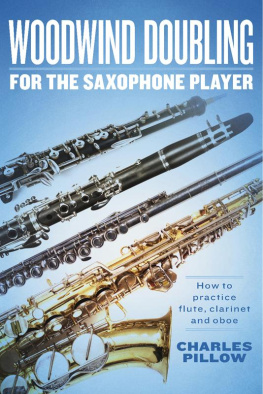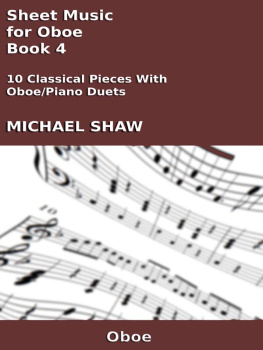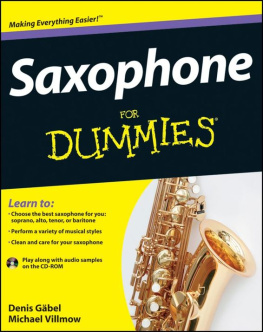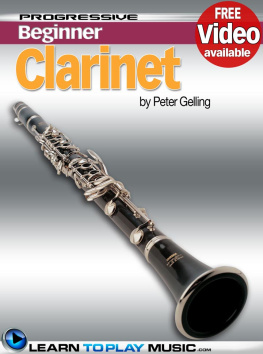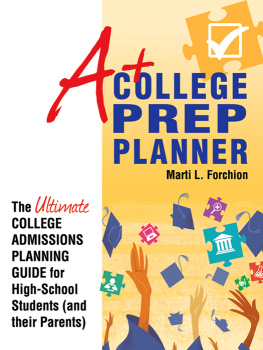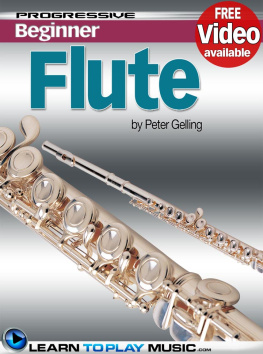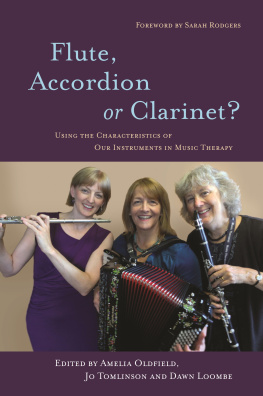Charles Pillow - Woodwind Doubling for the Saxophonist
Here you can read online Charles Pillow - Woodwind Doubling for the Saxophonist full text of the book (entire story) in english for free. Download pdf and epub, get meaning, cover and reviews about this ebook. year: 2013, publisher: BookBaby, genre: Children. Description of the work, (preface) as well as reviews are available. Best literature library LitArk.com created for fans of good reading and offers a wide selection of genres:
Romance novel
Science fiction
Adventure
Detective
Science
History
Home and family
Prose
Art
Politics
Computer
Non-fiction
Religion
Business
Children
Humor
Choose a favorite category and find really read worthwhile books. Enjoy immersion in the world of imagination, feel the emotions of the characters or learn something new for yourself, make an fascinating discovery.
- Book:Woodwind Doubling for the Saxophonist
- Author:
- Publisher:BookBaby
- Genre:
- Year:2013
- Rating:5 / 5
- Favourites:Add to favourites
- Your mark:
- 100
- 1
- 2
- 3
- 4
- 5
Woodwind Doubling for the Saxophonist: summary, description and annotation
We offer to read an annotation, description, summary or preface (depends on what the author of the book "Woodwind Doubling for the Saxophonist" wrote himself). If you haven't found the necessary information about the book — write in the comments, we will try to find it.
for high school, college and adult saxophone students learning to play flute, clarinet and oboe
Woodwind Doubling for the Saxophonist — read online for free the complete book (whole text) full work
Below is the text of the book, divided by pages. System saving the place of the last page read, allows you to conveniently read the book "Woodwind Doubling for the Saxophonist" online for free, without having to search again every time where you left off. Put a bookmark, and you can go to the page where you finished reading at any time.
Font size:
Interval:
Bookmark:

Introduction
The object of this book is to present a program for the saxophonist who wishes to begin or improve his flute, clarinet and oboe playing. Ive tried to narrow down what is absolutely necessary to practice to achieve the best results in the shortest amount of time. It is my belief that, for a doubler, the most important aspect of your flute, clarinet, and oboe playing is sound. Therefore, Ive organized this book in relation to long tones and narrowed the scope to exercises that deal primarily with tone.
Listen to Recordings
Listening to the great performers on each of the woodwind instruments should be a daily regimen and is almost as important as practicing.
The Benefit of Repeated Diligence
In my student days, I once asked a flute major how he got such a fantastic sound. He looked at me with disdain and said, I play long tones 4 hours a day. That was a very rude awakening indeed! Of course, you cant play 4 hours of long tones on flute, clarinet, oboe and saxophone in one day. But it underscores the importance of what repeated diligence can render. When you have 3 instruments to practice, you learn very quickly not to waste any time. You end up getting done in 15 minutes what used to take an hour. The focus here is on concentrated effort for a short amount of time, repeated on a daily basis.
Divide and Conquer
Each long tone exercise starts with the note on each instrument that is the warmest and easiest note to play and works step by step, note by note from there. For example, the middle B on flute is the clearest, most easily attacked note on the instrument. On oboe, however, Bb is the best note because of its warmth. Since each register on each instrument has its own unique problems, the exercises address each area on a separate basis. Once you feel comfortable in a particular register, you can then integrate that sound into the rest of the instruments range. As you might have guessed, this is not particularly easy. To quote Marcel Moyse, one of the most respected flute teachers, with time and patience and intelligent work one can accomplish these goals. The theory here is sort of a Divide and Conquer one, that is, note by note, register by register, you can develop a beautiful tone. A word of advice: BE PATIENT!
The Program
I recommend focusing primarily on one instrument while doing only maintenance practice on the others. That is, spend just 15 minutes a day on the instruments that you are not focusing on. For example, focus primarily on the clarinet for 3 months, and just do maintenance work on the other instruments, then switch to concentration on the flute for three months, and then the same with the oboe, and so on.
Another important point is worth mentioning here; if you want to play flute like a flute player, you must practice like a flute player, hang out with flute players, listen to flute players, go to flute concerts, join flute organizations, etc. Get involved with the instrument just like you are with the saxophone. Listen attentively to recordings and performances; listen to flute players the same way that you listen to saxophone players. Its the same as checking out John Coltrane or Stan Getz, Paul Desmond and Cannonball Adderley. Check out flutists James Galway and Jean-Piere Rampal or oboists Bert Lucarelli and John Mack. Listen attentively enough to distinguish between French, American, German, and Italian playing styles. Check out the differences of their sound, pitch, vibrato, etc. Also, talk to as many flute, clarinet and oboe players as possible. They will help steer you into good things, whether it is reed information and mouthpieces, embouchure placement, recordings, or pieces to play, etc.
As with most endeavors, experience is the best teacher. This means you might have to create your opportunities beyond the practice room. Put together woodwind quintets with your fellow doublers. Community orchestras, Doctors orchestras, etc, are always looking for players and they are a great way to gain experience. Community theatre, church gigs, weddings (by playing flute on bossa novas, clarinet on swing tunes, etc). Its the best way to learn pitch, projection, and how to match timbre with other instruments. It almost always feels different on the gig than it feels in the practice room. Scour your area for opportunities to perform.
The Sound
As saxophonists, we have many influences to draw on and the history of the instrument is tremendous. Coleman Hawkins, Johnny Hodges, Harry Carney, Lester Young, Charlie Parker, John Coltrane, Cannonball Adderley, Stan Getz, Sonny Rollins, Paul Desmond, Dexter Gordon, Wayne Shorter, David Liebman, Michael Brecker, and Joe Lovano are just a few of the many personal sounds and styles that have enriched the history of the saxophone. There are so many different sounds and colors to choose from and styles and players to emulate and gather ideas on how we each want to sound.
One the other hand, the history of the flute and oboe and clarinet is steeped in the classical tradition. Although there are many different sounds acceptable in the classical world, the parameters are less variable than in jazz. The only sound for those instruments is a fully controlled and in tune, classical sound. A perfect example of this is Paul McCandless, the oboe player with the popular jazz-world beat, new-age group, Oregon. He plays oboe like a classical player in relation to sound quality, but has developed his own approach to the instrument for the way he needs to play and with the musicians he plays with.
Another example is Eddie Daniels, the clarinetist who has made some fantastic crossover recordings that incorporate jazz and classical music. Eddie is a doubler who plays equally fantastic flute, clarinet, and saxophone who made his first impact as a saxophonist in the Thad Jones/Mel Lewis Jazz Orchestra in the late l960s. It wasnt until the late l980s that he began to focus primarily on the clarinet and it is on that instrument that he made his most popular recordings. Eddie is classically trained on all the instruments, who has his own unique sound on the clarinet, but one that is equally at home in classical or jazz music.
Hubert Laws made some of the classic jazz flute recordings in the mid and late 1970s for the CTI label. Some of them were crossover experiments like Rite of Spring and Romeo and Juliet but he has many straight ahead jazz recordings as well. He has a fantastic sound, classical in approach, facile technique and a vocabulary of his own. He is a player every doubler should know about.
Benefits of Doubling
When you study flute, clarinet and oboe, you undoubtedly study some of the greatest music ever written. Since the saxophone is a relatively young instrument, a great majority of symphonic and chamber music was written before its time. The flute and oboe sonatas of Bach and Handel are great examples of Baroque genius and many saxophone students never get to study or perform them. In studying these instruments, you might also get the chance to play the Woodwind Quintets of Mozart or Beethoven; something a saxophone player may never get to do. Not only do you get to play this great music, you get the benefit of learning a different style of music and of playing in a chamber group. There is a whole world of classical music that many jazz and commercial saxophonists may never experience.
Besides benefiting your musical scope as an instrumentalist, it is my belief that in playing and studying this music, your composition and improvisation skills are broadened as well.
Chapter One
Flute
One of the biggest challenges that the beginning flutist faces is the conception and application of the air stream. From a saxophone players point of view, the flute requires a more thoughtful use of the airstream; it plays a more vital role: pitch is affected more by it and the sound rides on the air column more so than on saxophone. The idea is to blow down and not across the blow hole. It is very common for the beginning flutist to hyperventilate when first learning the instrument. After a few days of practice, youll become accustomed to your expanded lung capacity.
Next pageFont size:
Interval:
Bookmark:
Similar books «Woodwind Doubling for the Saxophonist»
Look at similar books to Woodwind Doubling for the Saxophonist. We have selected literature similar in name and meaning in the hope of providing readers with more options to find new, interesting, not yet read works.
Discussion, reviews of the book Woodwind Doubling for the Saxophonist and just readers' own opinions. Leave your comments, write what you think about the work, its meaning or the main characters. Specify what exactly you liked and what you didn't like, and why you think so.

